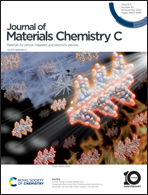Local and long-range helical structures of dendronized bisnaphthalimide mesogens with tunable torsional or planar configuration†
Abstract
A series of bisnaphthalimide (BNI) mesogens (BNI-3Cn and BNIA-3C12) consisting of two benzoylhydrazine dendronized naphthalimides connected by central links, i.e. single or triple bonds have been synthesized by palladium catalyzed Sonogashira and Suzuki coupling reactions. These BNIs could be regarded as C–C bond cracking derivatives of perylene bisimides (PBIs) and possess torsional or planar configurations depending on the types of the central links. The configurations could further lead to different molecular self-assembly processes, resulting in local helical structures in hexagonal columnar (Colh/p6mm) phases and long-range helical nanostructures in gels. It was proposed that BNI-3Cn with a single bond link having torsional configurations could form local helical structures via a spiral packing of propeller-like dimers. In contrast, BNIA-3C12 with a triple bond link having a more planar configuration could form local helical structures via the helical stacking of the supramolecular tetramers. The long-range helical nanostructures in gels were represented by the helical organizations of hexagonal assemblies of BNI-3Cn or lamellar assemblies of BNIA-3C12. BNI-3C12 has been explored for the preparation of a white light emissive device (WLED) and as a dopant to modify the PEDOT:PSS layer in n-Si/PEDOT:PSS heterojunction solar cells (HSCs).



 Please wait while we load your content...
Please wait while we load your content...